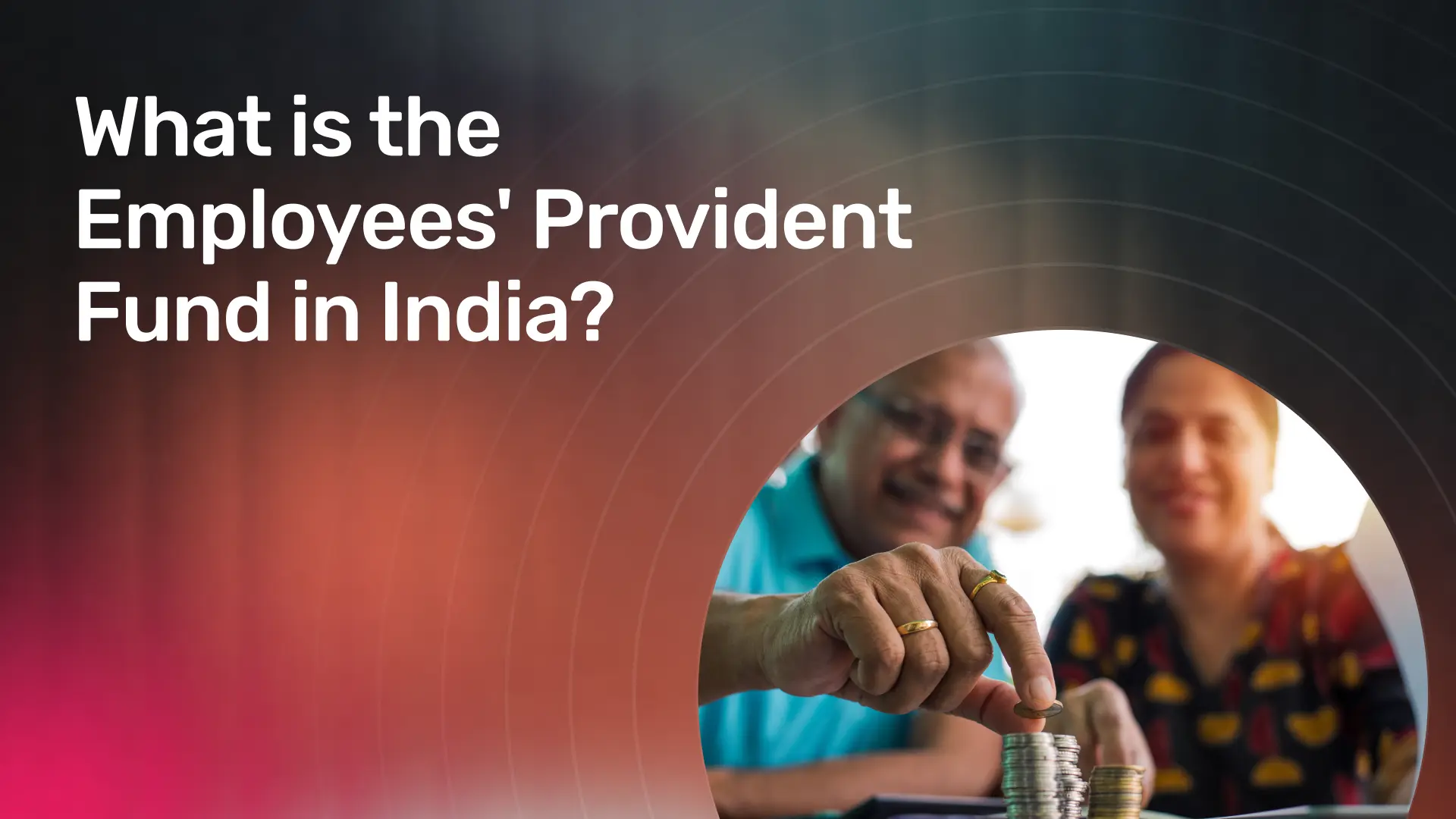What is the Employees' Provident Fund in India? Meaning, Eligibility and Benefits
The Employees' Provident Fund (EPF) in India is a long-term savings scheme that helps salaried individuals build a financial cushion for their future. It is managed by the Employees' Provident Fund Organisation (EPFO) under the Ministry of Labour and Employment. EPF is especially helpful after retirement or during emergencies, as it allows employees to save regularly throughout their working years.
In this blog, we’ll explain everything you need to know about the Employees' Provident Fund India — including its meaning, eligibility, contribution details, benefits, withdrawal rules, and how to check your balance.

What is the Employees' Provident Fund India?
The EPF or Employees' Provident Fund India is a government-backed retirement savings scheme designed for salaried employees in India. Mandated under labour law in India, both the employee and the employer contribute a fixed portion of the employee’s monthly salary into the EPF account. Each EPF member is assigned a Universal Account Number (UAN), which allows them to manage their PF account, check balances, and transfer funds when switching jobs.
Over time, this money earns interest and helps build a significant amount by the time the employee retires. The main goal of EPF is to provide financial stability to employees after retirement. However, employees can also use the fund for emergencies like illness, education, marriage, or buying a house.
Eligibility criteria for EPF
Who can enrol?
- All salaried employees working in companies with 20 or more employees are automatically eligible for EPF.
- Employees who earn up to Rs. 15,000 per month must contribute to EPF.
- Employees earning more than Rs. 15,000 per month can also join EPF voluntarily with the employer’s approval.
Employer registration
- All companies with 20 or more employees are required by law to register with the EPFO.
- Employers are responsible for setting up EPF accounts for their eligible employees.
- They must also deposit both their own and the employee’s share of the EPF contribution every month.
Exceptions and exemptions
- Employees of certain state or central government bodies may be covered under different pension schemes.
- Some small organisations with fewer than 20 employees can voluntarily choose to join EPF.
- Exempted establishments may maintain their own provident fund trusts, subject to EPFO rules.

Documents required for the employer’s EPF registration (India)
If you're setting up your business for Employees' Provident Fund (EPF) contributions in India, then registering with the Employees' Provident Fund Organisation (EPFO) is a key step. The required documents may vary depending on your business type, but here's a general breakdown to help you start preparing.
For sole proprietorships
Business owner documents:
- PAN card and Aadhaar card of the proprietor
- Any one of the government-issued photo IDs (e.g. passport, driving licence, voter ID)
- Proof of residential address (latest utility bill, rent agreement, etc.)
Business information:
- Business address proof (e.g. electricity bill or rent agreement)
- GST registration or Shop & Establishment licence
- Recent bank statement or cancelled cheque in the business’s name
- Digital Signature Certificate (DSC) of the proprietor
For partnership firms
Partner documents:
- PAN and Aadhaar cards of all partners
- Identity and address proof for each partner
Firm documents:
- Copy of the registered partnership deed
- Address proof of the firm's place of business
- Shop & Establishment licence or GST registration certificate
- Recent bank statement or cancelled cheque of the firm
- DSC of the authorised partner
For LLPs (Limited Liability Partnerships)
Designated partner documents:
- PAN and Aadhaar cards of designated partners
- Identity and address proof of each designated partner
Business registration:
- Certificate of Incorporation of the LLP
- LLP Agreement
- GST registration certificate or other business registration proof
- Office address proof
- Cancelled cheque or bank statement
- DSC of the authorised signatory
For private limited companies
Director details:
- PAN, Aadhaar, and valid ID proof for all directors
- Residential address proof of each director
Company registration details:
- Certificate of Incorporation
- Memorandum and Articles of Association (MoA & AoA)
- GST registration certificate or other business licence
- Office address proof
- Cancelled cheque or bank statement
- DSC of the authorised representative
For trusts and societies
Key member details:
- PAN and identity proof of the president and other board members
- Residential proof of all listed members
Organisation documents:
- Registration certificate of the trust/society
- Constitution documents (bylaws or memorandum)
- Address proof of the organisation
- Bank details with a cancelled cheque
- DSC of the person authorised to manage compliance
Other common documents required (All entity types)
- First invoice for sale and purchase (if available)
- Details of employees: name, date of joining, date of birth, father’s name, etc.
- Employee salary records or wage register
- Monthly headcount records
- PF contribution records (if applicable)
Pro tip: Make sure all scanned documents are clear, valid, and recent. A mismatch in basic details (like PAN or address) can delay the registration process.
Note: This is a general list of documents; please check the EPFO website for a detailed list.

Step-by-Step process of registering a company's EPF account
- Visit the official EPFO website: https://www.epfindia.gov.in
- Click on ‘Establishment Registration’ under the ‘Services’ tab.
- Register your employer account on the Unified Shram Suvidha Portal (USSP).
- Log in to the portal and fill in the ‘Employers’ Registration Form’.
- Upload all required documents.
- Submit the application form.
- On successful verification, you will receive your EPF registration number.
EPF contribution breakdown
Employee contribution
- Employees contribute 12% of their basic salary and dearness allowance every month.
- This amount is deducted automatically from their salary and deposited into their EPF account.
Employer contribution
- Employers also contribute 12% of the employee’s basic salary and dearness allowance.
- Out of this, 8.33% goes to the Employee Pension Scheme (EPS), and the remaining 3.67% goes into the EPF account.
Interest rates on EPF
- The interest rate on EPF is declared annually by the EPFO. For example, the interest rate for the financial year 2023–24 was 8.15%.
- Interest is calculated monthly but credited annually.
- The interest is calculated on the closing monthly balance using the formula:
- Interest = (Monthly closing balance × Interest rate) ÷ 1200
Note: The EPF interest rate is subject to annual revision. Always check the EPFO website for the latest update.
Benefits of Employees' Provident Fund India
Retirement savings
- EPF acts as a retirement savings fund, helping employees accumulate money over their careers.
- On retirement, the employee receives a lump sum amount, which includes their own contribution, the employer's contribution, and interest.
Tax benefits
- Employee contributions to EPF are eligible for tax deduction under Section 80C of the Income Tax Act (up to Rs. 1.5 lakh per year).
- Interest earned and the final amount received after five years of continuous service are tax-free.
Loan facility
- Employees can take a loan or partial withdrawal from their EPF for specific purposes like:
- Purchase or construction of a house
- Medical emergencies
- Higher education or marriage of self or children
- These loans do not require repayment like bank loans.
Premature withdrawal
- Partial withdrawals are allowed before retirement under certain conditions, such as:
- Marriage
- Education
- Illness
- House purchase or renovation
- Unemployment for more than one month
Employer contribution
- Employers contribute a similar amount to the employee every month.
- This increases the total savings in the employee's EPF account over time.
Pension benefits
- Part of the employer’s contribution (8.33%) goes into the Employee Pension Scheme (EPS).
- After retirement, employees who have completed at least 10 years of service are eligible for a monthly pension.
Financial security for the family
- In case of an employee’s death during service, the total EPF amount is given to the nominee.
- This ensures that the employee's family is financially supported.
Additional benefits
- EPF members are automatically enrolled in the Employees' Deposit Linked Insurance (EDLI) Scheme.
- Under EDLI, the nominee can receive up to Rs. 7 lakh as an insurance payout in case of the employee’s death.

EPF & EPS forms – List, purpose & who should use them
| Form | Purpose | Who needs it |
| Form 2 | To nominate beneficiaries for Provident Fund and Pension benefits | All EPF members – usually submitted at the time of joining |
| Form 5 | To report new employees eligible for EPF to the EPFO | Employers – submitted when new joiners become eligible for PF |
| Form 10 | To notify EPFO when an employee exits the organisation | Employers – used when someone leaves their job or retires |
| Form 11 | To declare past EPF membership when joining a new company | Employees – especially important if they want to continue the same UAN |
| Form 13 | To shift your Provident Fund balance to your new employer | Employees changing jobs who want to transfer PF funds |
| Form 14 | To use your PF savings for paying a Life Insurance Policy | EPF members looking to use funds for LIC premium payments |
| Form 15G / 15H | To avoid TDS deduction on PF withdrawals if within the tax exemption limit | EPF members withdrawing before 5 years of service, meeting income criteria |
| Form 19 | To withdraw the Provident Fund amount after leaving a job | Employees who have resigned, retired, or are unemployed |
| Form 10C | To claim pension benefits under the Employees’ Pension Scheme (EPS) | Applicable for pension withdrawal or scheme certificate requests |
| Form 10D | For a monthly pension withdrawal after retirement | Used by retirees or their families for monthly pension payments |
| Form 20 | For a family to claim the PF amount after the death of a member | Nominees/legal heirs of a deceased EPF member |
| Form 10R | For claiming pension benefits for a child of a deceased EPF member | Guardian of the child who is eligible for pension benefits |
| Form 5(IF) | To claim EDLI (Employees' Deposit Linked Insurance) benefits | Used by nominees or family after the death of an employee |
| Composite claim form | A consolidated form to claim PF, pension and insurance in one go | Available in Aadhaar and non-Aadhaar versions for employees |
EPF withdrawal rules
Retirement withdrawal
- Employees can withdraw the full EPF amount once they retire at the age of 58.
- They can also make a partial withdrawal after turning 55, within one year of retirement.
Job change
- Employees should not withdraw their EPF when switching jobs. Withdrawing EPF at every job change resets the tax-free 5-year service period.
- Instead, they can transfer the EPF balance from the old employer to the new one using their Universal Account Number (UAN), which will help in preserving the tax benefits and ensure a larger retirement corpus.
Loan facility
- EPF allows partial withdrawals that work like advances, not actual loans.
- There is no repayment, and the amount is deducted from the balance.
Premature withdrawal
- If an employee is unemployed for over one month, they can withdraw 75% of their EPF balance.
- If unemployment continues for two months, the remaining 25% can also be withdrawn.
- Withdrawals due to illness, disability, or family emergencies are also allowed.
Methods and steps to withdraw the EPF amount for employees
Online method:
- Visit the EPFO member portal: https://unifiedportal-mem.epfindia.gov.in/memberinterface/
- Log in using UAN and password.
- Go to ‘Online Services’ and select ‘Claim (Form-31, 19, 10C)’.
- Enter the last four digits of your bank account and verify.
- Choose the type of withdrawal (full, partial, pension, etc.).
- Submit the claim. Amount is usually credited within 15–20 working days.
Offline method:
- Download and fill out the required form (e.g., Form 19, Form 10C).
- Submit it to the EPFO office through your employer.
- Provide a cancelled cheque and KYC documents.
- The amount is processed and transferred to your bank account.

Steps to transfer EPF money
- Enter your UAN and password to log in to the EPFO Member Portal.
- Within the portal, locate and click on the 'Online Services' tab.
- Select the 'One Member – One EPF Account (Transfer Request)' option to begin the transfer process.
- Fill in your previous and current employer details.
- Choose either the previous or current employer to verify the transfer.
- Submit the request and download the acknowledgment.
- The employer will digitally approve the request, and the funds will be transferred.
How to check EPF balance
- Visit the official EPFO website: www.epfindia.gov.in.
- Log in using your UAN and password to view your passbook and contribution details.
UMANG app
- Download the UMANG app and link it with your UAN.
- You can check your balance, claim status, and other EPF services on the app.
SMS service
- To check your EPF balance, text "EPFOHO UAN ENG" to 7738299899 using the phone number linked to your EPF account.
- You will receive your EPF balance details in reply.
Missed call service
- Dial 011-22901406 using your registered mobile number to request your EPF balance.
- You will then receive an SMS with the relevant information.
Monthly passbook download
- Log in to the EPFO member portal and download your passbook for detailed monthly contributions.
- This helps you keep track of both your and your employer’s contributions.
How can Native Teams help?
Managing EPF compliance can be time-consuming and complex, especially for growing businesses, global teams, or companies new to the Indian market. That’s where Native Teams comes in.
As your trusted Employer of Record (EOR) and global payroll partner, Native Teams takes care of all employment and payroll formalities in India so you don’t have to. Whether you're hiring full-time employees or managing a distributed team across India, our local experts will handle everything on your behalf.
If you're looking to expand your team in India and provide your employees with all the necessary employment benefits in India, without setting up a local legal entity or getting buried in EPF paperwork, Native Teams makes it easy to stay compliant while keeping your employees secure and supported.
Final takeaway
The Employees' Provident Fund India is more than just a retirement scheme — it’s a way for people to save up a small portion of their income for the future without hindering their monthly expenses or budget. With regular contributions from both employee and employer, tax savings, interest earnings, and added benefits like pension and insurance, EPF offers strong financial support. So, stay informed about your EPF account and watch your savings add up.
